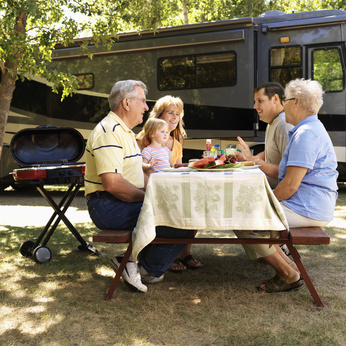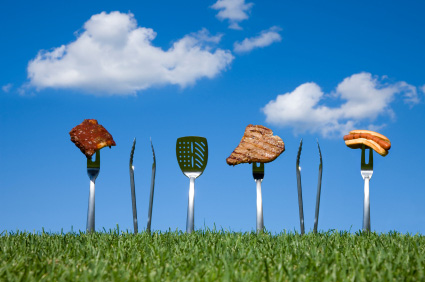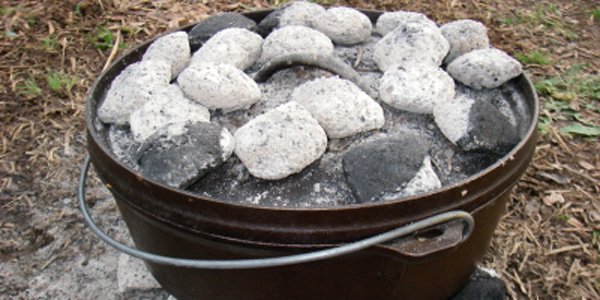
Cooking in the RV
 Cooking in the RV
Cooking in the RV
RV kitchens are cozy, efficient, and handy “rooms” that travel with you. Their only downside is their small side—which can be a benefit, depending on how you look at it. After all, you don’t have to take as many steps to get from the stove to the refrigerator, so it’s very efficient. You can make just about anything in your RV kitchen that you would at home, assuming yours comes with a small oven or microwave. If it doesn’t, never fear—you can always bake using a Dutch oven on top of a burner. With a little pre-planning, you’ll come to love your snug little galley!
Plan Ahead
Because of the limited storage space in an RV, you don’t want to pack anything you aren’t likely to need. If the menu for your trip doesn’t call for a soup pot, or a cast iron frying pan, you might as well leave those things at home. So the first key to packing your RV kitchen is to plan ahead. Make a calendar (or photo copy a wall calendar) and write out the day’s meals in each square. Once you’re on the road, you can switch the meals around, so long as you eat them all! And of course there’s always room for last-minute changes, but having a plan will help you prepare.
As you write out the menu for each meal, keep one list of ingredients and another for cooking equipment. For instance, a pasta supper might require “noodles, sauce, cheese, basil, and olives” in the ingredients section and “pot, saucepan, grater” in the equipment list. As you fill your menu, you’ll get a good sense of what cooking gear you absolutely have to have and what you might live without. When it comes to equipment, be frugal! If you can strain your pasta using the lid and not bring the colander, that’s a decision that will save you space.
Recipes
Look for recipes that are quick to make and that use very few pots and pans. One-pot meals are perfect! You might also invest in a crock pot or other slow-cooker. When you’re at a camp site for the day, you can plug your slow cooker in, fill it with soup or stew ingredients, and come home to a delicious meal that’s ready to eat.
Every day on the road, when you have breakfast, take stock of your supplies. Are there leftovers you could finish off? Ingredients that you need to use up? Adjust your menu to fit the state of your cupboard.
Plan to Buy Food Along the Way
Refrigerator space is often at a premium in an RV. The solution? Buy fresh fruits and veggies as you go. This not only saves you space, it also give you a chance to interact with the communities you’re traveling through. Visit farmer’s markets and sample local treats or stop off at farmer’s stands as you pass through farm country. Keep your quantities small by only buying what you truly need.
Packing Up
Certain items are a necessity, so be sure to bring:
- a good-sized pot
- frying pan
- Tupperware
- Cooking spoon/spatula
- Can opener
- Spice kit (with salt, pepper, Italian seasoning, other herbs and spices)
- Individual plates, cups, and utensils
- Matches or a lighter for campfires
The Art and Science of Grilling
Nothing says summer like the smell of food grilling in your campsite.
Grilling is the perfect way to cook outdoors. It is, after all, an outdoor cooking method! You can prepare just about anything on the grill, from burgers and steaks, to fish and vegetables.
The Backpacker's Kitchen
The Backpacker's Kitchen
When you’re backpacking, weight is your number-one concern. Before you pack for your trip, lay out all of your equipment, including kitchen equipment, to see if you can trim anything. If you can make do with one pot instead of two, then do it! By the same token, you’ll want to choose foods that are lightweight (and dried, ideally). Below is a list of absolute necessities in the backpacking cook kit.
Cook Kit
- A lightweight backpacking stove
- Fuel bottle and an extra fuel bottle
- Cook pot and lid
- Small frying pan, if needed
- Wind screen (made of foil)
- Lighter and matches
- Cleaning equipment (biodegradable soap and a small scrubby)
- Cooking utensil, such as a long-handled spoon
- Water bottles
- Water treatment equipment (iodine, chlorine, etc.)
- A bear bag, if you’re headed into bear or raccoon country
- Rope for your bear bag
- Dining Equipment: a bowl/cup, spoon
- Sharp, Swiss-army type knife
- Spice Kit – use Ziploc bags or film containers to store salt, pepper, Italian seasoning, thyme, cumin, and other herbs and spices
- Oil
Food Ideas
Depending on your location and the weather, you may decide to use your stove for every meal, or you may only get it out for dinner and evening cocoa. Either way, be sure to bring a combination of hearty, filling food and those little special treats that will feel like luxuries after a day of hiking.
To keep your pack light, plan on rehydrating most of your food. Oatmeal, pasta, rice, couscous, dried refried beans, and quinoa are all lightweight. You can buy dried fruits, vegetables, and protein mixtures at most grocery stores. Soup mixes are also terrific to eat as soup or to use as seasoning for your pasta dinner. Bread tends to get crushed in backpacks, but tortillas travel well. Try making individual pizzas on a tortilla in your frying pan (lay your ingredients on half the tortilla in the pan, let the cheese melt, then fold the tortilla over like an omelet). Have fun, and don’t forget the dessert!
Cooking Outside the Pot
Cooking Outside the Pot
The next time you go camping, why not try a cooking method that goes beyond the usual pots and pans? Alternate methods are a challenge. And when you use a different method, your kids can even get in on the act and help with the cooking!
Kid-Friendly Cooking Methods
Share the cooking burden by letting the kids lend a helping hand.
Stick Cooking
If it involves holding a stick over the fire, the kids can do it. Let them cook their own hot dogs, dough boys, and marshmallows this way. Remember, food cooks better and faster over coals than over flame. And don’t let your food catch on fire!
Foil Cooking
From banana boat desserts to full meals, foil cooking gives you plenty of freedom. When your wrap your ingredients in a foil pouch and place it in the coals, you’re essentially steaming your food. Let the kids put together dinners with carrots, onions, potatoes, and ground beef, or create your own combination. This is a terrific way to prepare vegetables, to bake apples and other fruit, or to poach fish and other meat. Wrap a potato in foil and place it straight in the coals for an old-fashioned treat.
Inside Other Food
You can use the discarded outer shells of other food items as a wrapper for your meal. Try baking muffins inside a hollowed-out orange or beef inside cabbage leaves. Wrap your finished product up tightly (possibly in foil) to keep ash from getting inside.
Adult Cooking Challenges
If you’re feeling more adventurous and are up for a challenge, try one of these back country cooking methods.
Coffee Can Cooking
This is an alternate to pot cooking. Instead of placing a pot on a grate or on three rocks, you can set your coffee can directly in the coals. Fill it with your ingredients and cover it with a lid or metal plate. This method is best for heating up soups, stews, and other liquid-based dishes.
Cook on a Rock
Yes, you really can cook on a rock. Before you light your fire, rinse and clean off a flat-topped rock. Set it near (but not directly in) the heart of your fire. You want heat and plenty of coals, but not open flames. Let the fire burn for an hour or two before you begin cooking, so the rock will be piping hot.
Paper Cooking
Soak a piece of paper in water and use it to wrap fish, apple slices, or any other ingredients that will cook fairly quickly. When the paper is wet, it won’t burn. Set it on a hot, flat rock near (but not in) the flames.
Solar Ovens
Lightweight solar ovens are easy to assemble. If you want to try baking a cake or biscuits on your next camping trip, consider a solar oven. Of course, you’ll need good weather to make this work! Solar Ovens are best used in full sunlight.
Dutch Oven Cooking
Dutch Oven Recipes for Piping Hot Baked Goods for Camping Trips
For hundreds of years, people have been using Dutch ovens as their portable bakeries. These cast-iron pots are made to sit right in the coals. With their heavy lids, you don’t need to worry about ash and soot blowing into your food, and burning is rarely a problem with Dutch ovens because the cast iron spreads the heat evenly. If you place hot coals on the lid of the Dutch oven, you decrease your cooking time and help the food bake at an even rate. You can bake just about anything in your oven, from tasty desserts to main courses. The next time you’re car camping or heading out in the RV, pack up one of these classic cooking tools and give it a try!























